Agriculture and MGNREGA as Rural Livelihoods amidst Covid-19
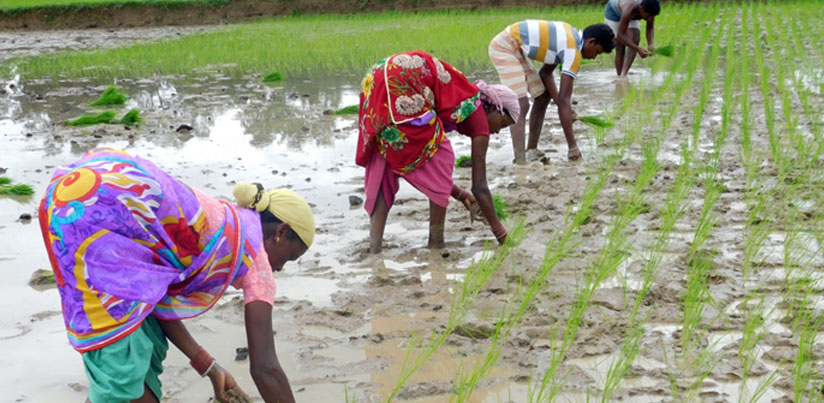

PC: Ashutosh Nanda
Using the provisions under MGNREGA to gainfully engage the thousands of migrant labour, who are fleeing big cities and returning to their villages, is a productive way to turn the global crisis created by the COVID-19 pandemic into an opportunity for creating assets that support rural livelihoods and lead to self-sufficiency.
T his article presents a perspective on rural livelihoods during the Coronavirus disease (COVID-19) pandemic and the ways in which it can be effectively dealt with. It presents opportunities that exist in the present ecosystem, and how MGNREGA and agriculture can boost and support rural economy in these difficult times and make people self-reliant. It presents the impact of the High Impact Mega Watershed Project in Chhattisgarh, instrumental in ensuring that sufficient people-centric workplans, which support MGNREGA functionaries in opening more and more work, are available.
Coronavirus, Reverse Migration and Rural Lives
T he COVID-19 pandemic has forced governments across the world to take measures to protect citizens and ensure food security for the entire populace. For obvious reasons, developing countries are more prone to the ill impact of COVID-19 because poverty and malnutrition are rampant, and the effect is aggravated by the poor public health infrastructure across rural areas. Initially, it seemed as if rural areas would be untouched and would be saved from the disease due to their interior and cut-off locations. However, soon, cases were reported in tribal areas as well as in semi-rural pockets, leading to panic among communities; one of the major reasons for this was the return home of those who had migrated to cities.
In rural areas, the income of households is irregular even during normal conditions, and livelihood opportunities are limited. In a lockdown situation, there has been a sudden inflow of migrant labour, a difficulty in procuring inputs for agriculture and a decline in demand from the markets. The uncertainty has increased; people are also uncertain about future opportunities for wage employment in formal and informal structures.
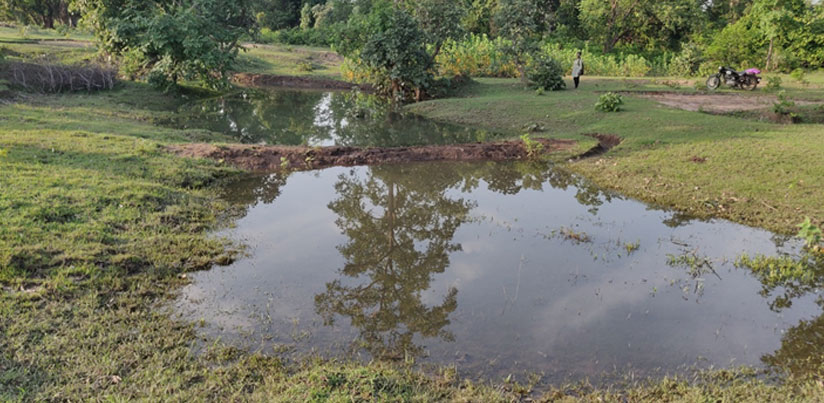
PC: Ashutosh Nanda
A s per Census 2011, in India, 37 per cent of the total population, that is, 45 crore people, migrate in search of livelihood opportunities. In the context of Chhattisgarh, the Census data indicate that 88,88,075 villagers move to nearby cities within or outside the districts to which they belong. If we extrapolate this figure, we can expect an exodus of more than 1 lakh labour back to the state in a span of one month. Several efforts are being made by the government, civil society organizations (CSOs), women-led collectives, PRI members and local administration for facilitating this integration and reducing the drudgery of labour returning to their homes. Many steps are being taken towards this end, including providing food and transport, creating shelters and building awareness in the interior areas. However, the sustainability of such interventions in the coming days is not assured because resources are scarce and may end soon. Also, there is a high chance that due to the adverse conditions they faced in the cities, the labour may not want to return to cities any time soon; short-term measures for accommodating them in the rural economy, thus may not be very effective.
With the inflow of migrant labour in huge numbers, state governments are facing a dual challenge: one is short-term, that is, to prevent the spread of disease and the second is long-term, namely, to accommodate them in the village economy in a productive manner. Many of these people have lived away for years and, hence, have very little social and economic footing in the villages, thereby increasing their insecurity many fold. In such conditions, MGNREGA and agriculture can play an unprecedented role in integration of the migrant labour in rural economy.
With the inflow of migrant labour in huge numbers, state governments are facing a dual challenge: one is short-term, that is, to prevent the spread of disease and the second is long-term, namely, to accommodate them in the village economy in a productive manner.
MGNREGA has emerged as the single, largest, government-sponsored scheme aimed at providing employment to the rural populace and aimed at reducing migration. If leveraged correctly, it can provide some support to the labour that is returning to the villages. This is possible only when communities and field staff have the capacity to plan for their villages and are aware of those provisions made under the Act for the most vulnerable sections of society.
Limitations and Opportunities
B udget allocations for MGNREGA have already been made as per the requests of the state government when no pandemic situation existed; the scope of reverse migration of people to villages, therefore, was almost nil. As the number of workers returning to villages increase, these allocations will need to be periodically revised.
An additional allocation by the Finance Minister, Nirmala Sitaraman, of Rs 40,000 crores is a welcome move; it may need revision on an area basis as per the number of people returning. In Chhattisgarh, 908.65 lakh person days till 15th July 2020 have been generated, which is almost 67 per cent of the total approved labour budget of Rs 1,350 lakhs. It also highlights the need to allot more funds before the present budget is exhausted.
Accommodating Migrants In The Long Run
T he return of the migrant labour in such large numbers was sudden and unanticipated; there was very little time to ensure that systems are in place so that they can be skilfully employed in rural eco systems. At present, such possibilities seem to exist only in the agriculture sector and through MGNREGA, which engages a large number of workers every year
In Chhattisgarh, there is a provision of a maximum of 100 days of wage employment to all households whereby adults are willing to do unskilled labour work. The average days of employment provided per household is only 56, 57 and 52 in the financial year 2019–2020, 2018–2019 and 2017–2018, respectively. This indicates that there is immense scope to increase the average days of employment per household in the coming years. Additionally, in 2019–20, only 10 per cent of the households completed 100 days of employment and 776 gram panchayats (GPs) had nil expenditure, proving that the pace of implementation of work is not uniform across the GPs and the full potential of these schemes is not being utilised in the present framework. The labour budget has also increased, from Rs 900 lakhs in 2016–17 to Rs 1,350 lakhs in 2020–21. The percentage utilization of the budget in 2019–20 was 104.76 per cent, indicating the keen interest of rural communities in MGNREGA works. (Source-https://www.nrega.nic.in/netnrega/mgnrega_new/Nrega_home.aspx )
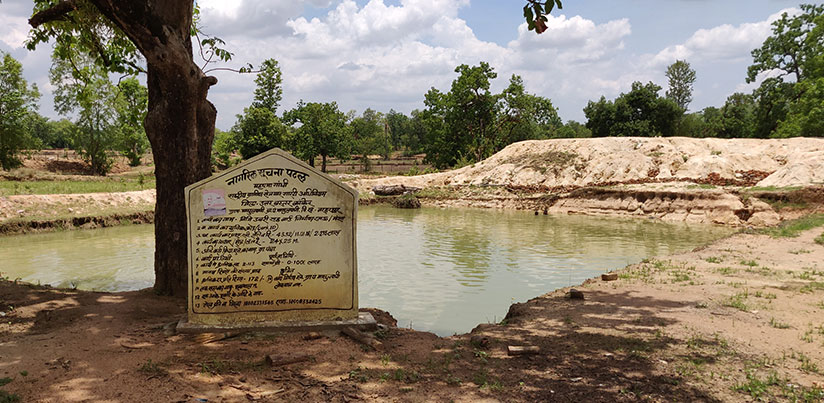
PC: Ashutosh Nanda
I f MGNREGA is used to enhance the abysmal irrigation facilities existing in the villages, it can change the fate of many farmers in the coming years and enhance their income in the long run. It will also provide immediate employment and give villagers an opportunity to work in the village ecosystem.
If we take following steps, the ground implementation of MGNREGA can be further intensified.
- Increasing the limit for person days from 150 days to 200 days to ensure that each household has the opportunity to earn a substantial amount.
- Making work available at the hamlet level and simplifying the demand generation process so that more and more people engage on a regular basis
- Increasing budget allocations, wherein the high level of migration is expected to accommodate all the labour.
Creating Assets through MGNREGA and Opportunity For Improved Agriculture
M onsoons are about to start this year. Agricultural productivity will matter more this year because it will ensure the availability of food grains for the entire year because other avenues of income are disrupted due to the COVID 19 menace. Strengthening farm and non-farm livelihoods can pave the way for food and nutritional security, which can be effective in fighting CORONA and ensuring that the rural economy does not crumble under the pressure of accommodating migrant labour. For any farm and non-farm initiatives to be successful, water availability is imperative. There was deep discontentment among the farmers prior to the COVID menace because the irrigation facilities in most of the areas are non-existent and monsoons are usually erratic. Government schemes reach only a few beneficiaries, leading to large patches of land lying useless and barren.
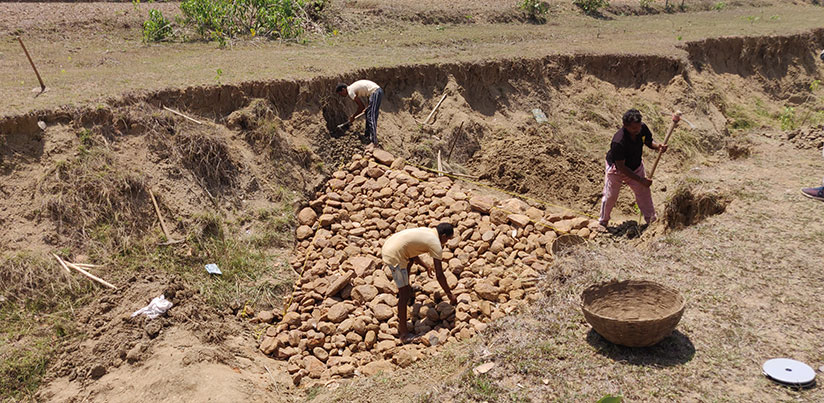
Loose Boulder check Dam for Soil Erosion; PC: Ashutosh Nanda
I ntense soil erosion from the uplands and its deposition in the fertile lowlands further reduces agricultural productivity, rendering the efforts of farmers useless. The situation will become grave unless we consciously make efforts to increase the storing capacity of our water harvesting structures such as ponds, dig new ones and reduce the speed of flowing rainwater. Water harvesting structures, plantations, canals and all the land development activities will lead to a decrease in the run off and an increase in water percolation. With proper planning, this will lead to increased cropping intensity and the effective use of barren lands.
MGNREGA assets have shown the potential to increase water storage and ground water level in rural areas. In most of the areas of CG, the rainfall is generous; however, it runs off due to undulating terrains, steep slopes and deep valleys. This year, as per weather predictions, monsoons are expected to be normal, which is good news; what will matter, however, is how this water will be used and conserved for future use. The MGNREGA worklist also permits the creation of NADEP compost pits, which can be used to create organic manure, much needed in abundance in villages both for paddy and vegetable cultivation.
In the financial year 2020–21, work under MGRNEGA started after the Ministry of Home Affairs (MHA) included additional activities, and instructed that the works in the villages be implemented, with strict adherence to physical distancing and the use of masks in work sites. In a letter dated 15 April 2020, the states were asked to give priority to irrigation and water conservation works, in both individual and community lands, and to start MGNREGA work from 20 April 2020. In fact, as per the report of the Ministry of Rural Development (MoRD), Chhattisgarh topped in person days and 24 per cent of the total jobs across the country were provided in the state.
Additional Measures To Strengthen Field Level Implementation
Some steps that can make MGNREGA a stronger weapon in fighting CORONA are:
Doorstep Cash Availability of MGNREGA Payments
Kharif agriculture is a money-intensive activity because it involves the procurement of inputs such as seed, fertiliser, pesticide, and the preparation of land for sowing. Cash is also needed for transportation and to pay the labour involved in transplanting and weeding. In the present scenario, moving from the villages to the banks and maintaining social distancing norms in the banks can be incredibly challenging.
Therefore, it is important to find innovative ways by which cash payments are made, and cash transactions in banks are simplified. MGNREGA payments should be made cash-based instead of Direct Benefit Transfer (DBT), specifically in the interior areas, where financial institutions are located far away.
Second, the Banking Correspondent and Bank Sakhi model should be strengthened. Banking Correspondents are a link between banks and the people and this model has been successful in Telangana. People withdraw money when they need it through digital transactions. This model can be also explored in CGs. This will also be beneficial in withdrawing money for other social security schemes as well. (Source: https://telanganatoday.com/doorstep-banking-services-ensuring-cash-availability-in-rural-telangana )
Investment in People
The experience of PRADAN with rural communities proves that people-centric approaches for development last longer and are more sustainable. This is also applicable in the case of MGNREGA planning and implementation. When community members are the beneficiaries and their involvement is low in the entire planning process, there is a lack of understanding and capacity on the nuances involved in the planning processes. In case, a systematic plan is made to build the capacities of people and MGNREGA staff on the key principles of watershed planning, water budgeting concepts and the utility of various watershed structures, the planning process for each year will become simple and will cater to the needs of the people. It also helps the community visualise the change in the landscape through land and water treatment measures and increases their sense of ownership of the assets created. The creation of a technically sound, ground-level cadre will also ensure that MGNREGA is leveraged to create maximum potential for water harvesting and the benefits will reach the most vulnerable families.
Some other steps that build the confidence of the community about the planning process are the transect walk and the prioritisation of work in the gram sabha. A transect walk with community members helps in determining whether the planned structures are feasible as per the slope of land and the geomorphology. The prioritization of this work in the gram sabha ensures transparency and allows for the work of the weakest section of the village is done first.
As a result of these approaches, a comprehensive livelihood plan has been formulated, which envisages treatment in a continuous area called patch treatment and not the creation of individual structures here and there. This also ensures that there is no dearth of plans that are to be considered on a need basis.
Migrants as Agri-entrepreneurs and Farmers Collectivisation
The biggest challenge farmers have faced for long is the lack of extension services for farm and non-farm livelihoods. Correct information about crop and livestock management does not reach farmers on time and usually leads to losses. These losses cloud the risk-taking abilities of the farmers and they avoid anything that is a non-conventional livelihood option. In this context, migrant labour, who have returned to their villages, can be trained as resource persons for farm and non-farm livelihoods. If done now, this will act as a support to the rural families in the kharif as well as the rabi seasons. Even if 50 per cent of the labour stay back in the villages, they can become a valuable resource for the villages. They can be remunerated using funds from National Rural Livelihoods Mission (NRLM) or individually by families. The agriculture department officials and CSOs working in the region can conduct capacity building and other trainings.
Another step to improve the net output income is the collectivization of farmers in Farmer Producer Groups and the formation of Agriculture Production Clusters (APCs). Such an approach will give farmers better bargaining power, both during input procurement as well as during the selling of the produce. The scale and the collective approach can increase the net profit farmers earn drastically.
In case the produce does not fetch a good rate, farmers should have the option of godowns and cold storage facilities that do not exist at present. Such facilities, if made available at the block level through convergence with MGNREGA can be a great boon for all the farmers in the region.
All these options are long term and can lead to successful and productive engagement of the extra workforce that has returned to the villages. It will also provide them with a means for earning money.
| Activity | Stakeholders Involved | Role |
| Capacity building of migrant workers and their conversion to Agri-Service Providers | Agriculture department and CSOs | In providing training and capacity building |
| Formation of APCs and Forest Production Organisations | Agriculture department, CSOs and women collectives | Community mobilization, training, and capacity building |
| Creation of cold storage facilities | MGNREGA cell, Panchayati Raj Institution (PRI) members, Agriculture department and women’s collectives | Planning and implementation |
High-Impact, Mega Watershed Project and Its Relevance In Covid 19
A cknowledging the impact MGNREGA has on agriculture and rural lives in CG, a mega watershed project has been initiated whereby the state government and CSOs are working together to increase the income of 1,00,000 small and marginal farmers through water conservation and land treatment measures. It envisages strengthening the present systems and making them more people-centric and robust. This is also supported by Axis Bank Foundation and Bharat Rural Livelihood Foundation.
The project focusses on building the capacities of ground-level functionaries, involved in the implementation of MGNREGA, and of the rural communities involved in the planning on watershed principles and land restoration. Since the inception of the project, many trainings have been organised for CSO staff members, Rozgar Sahayaks, PRI representatives and Self-Help Group (SHG) members on various provisions under MGNREGA and watershed principles. This project is being implemented in 26 blocks of 12 districts spread across central, northern and south Chhattisgarh. Of the 26, 13 are intensive blocks, meaning that CSOs will be engaged directly on the field in community mobilization and work implementation with the MGNREGA cell. In these, 36,75,849 labour days have been generated and Rs 1,321.71 lakhs have been disbursed as wages, serving as a huge support to rural households (for this financial year, as on 4 June).
Another significant part of the project is the use of water budgeting principles when planning for water harvesting structures and for protective irrigation measures. Water budgeting, that is, assessing the water requirement for all the households, presents a clear picture of water received, required and harvested. This helps community members picture the change and believe that water-sufficient villages are possible.
Under the High Impact Mega Watershed Project, CSOs have ensured that the plans prepared are extensive and include vulnerable communities. The plans are made for 5 years and prioritization is done for each year. For each gram panchayat, a detailed project report (DPR) is prepared, wherein details of all the plans and beneficiaries are included. These readily available plans are extensive and made with the active participation of community members.
T This aspect differentiates the project and non-project blocks because without proper process work cannot be sanctioned. In the project blocks, the aim is to treat 7 lakh hectares of the catchment area by leveraging funds from MGNREGA; the files for the planned structures have already been submitted. The advantage of this is that, even during lockdown, there was ample amount of work sanctioned or submitted to the janpad panchayat.
Planning for works under MGNREGA, which can be carried out during the monsoon, has also started, and the process of documentation is under way. Such phase-wise planning for different seasons enables GPs to open work throughout the year and reduces delay.
Since the inception of the project, 57,402 structures have been proposed, which will change the landscape in a significant manner in the next few years. In FY 2020–21, 16,131 structures have been planned with 17,396 households. Also, GPs under the project are better equipped to accommodate migrant labour because plans for the next few years are ready and can be implemented as per availability of labour.
Emergence of Integrated Livelihoods
Access to water has allowed medium- and small-scale farmers to diversify livelihoods; they are now exploring non-traditional methods of income generation. The additional income has started coming from fishery and plantation activities that emerged due to the availability of water in the lean periods. Fishery is gaining popularity in the project areas because the income is good and the family can also use it for fulfilling its nutritional needs.
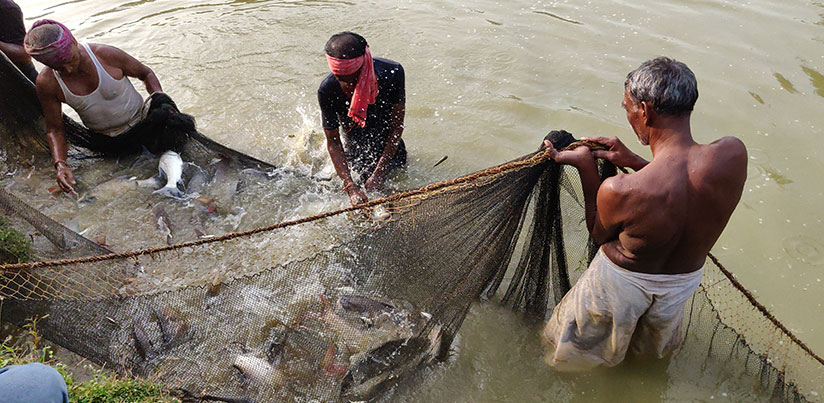
Fish Rearing in Farm Pond; PC: Ashutosh Nanda
F or production and quality enhancement of farm-based and forest-based produce, a separate component has been added, with support from Ford Foundation. Under this, 9,000 households have been provided support and training on farm-based activities and 81 farmer field schools have been established. Farmers are excited because this is the first time that the use of water is being linked to their livelihoods. In addition, 13 seedbanks have been established and 187 indigenous local seeds of different crops have been preserved. In the backyard poultry and goat rearing activities, support has been extended to 1,259 households. .
Way Forward
I n conclusion, it can be deduced from the above that rural livelihoods majorly revolve around water availability, which can be ensured by creating assets under MGNREGA. In a crisis like this, MGNREGA can play a pivotal role in providing employment as well in creating large-scale assets that will improve agricultural productivity and ensure prosperity in the villages for many years ahead. People-centric approaches and scientific planning should be implemented and funds from MGNREGA should be dovetailed in these
In a crisis like this, MGNREGA can play a pivotal role in providing employment as well in creating large-scale assets that will improve agricultural productivity and ensure prosperity in the villages for many years ahead.
There is immense need to implement more projects like the Mega Watershed Project, which will make community members and PRI representatives confident and provide them opportunities to rejuvenate their natural resources and strengthen livelihoods.
The abridged version of the article was earlier published in India Water Portal
https://www.indiawaterportal.org/articles/boosting-rural-livelihoods-using-agriculture-and-mgnrega-amidst-covid-19


2 Comments
I’m extremely inspired with your writing talents and also with the structure to your blog. Anyway stay up the excellent high quality writing, it’s uncommon to peer a great weblog like this one these days.
Hi my loved one! I wish to say that this article is awesome, nice written and come with approximately all important infos சேலை. I would like to peer extra posts like this .